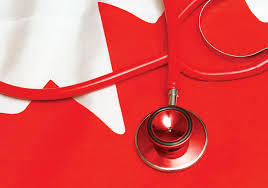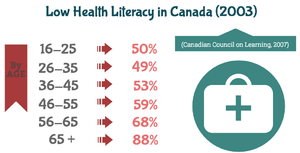Health Literacy in Canada

Overview
Canadian Public Health Association (CPHA) defines health literacy as “the ability to access, comprehend, evaluate, and communicate information as a way to promote, maintain, and improve health in a variety of settings across the life-course”. [1] The definition acknowledges the importance of different health contexts regarding literacy rate and accessibility of health-related resources. According to the Canadian Council on Learning (CLC), approximately 60% of adults and 88% of seniors in Canada do not have such ability to access, understand, and use health information and services to manage their health.[2] There is a need to improve health literacy concerning that it has a direct impact on health status and well-being of Canadians. Low health literacy may lead to poor health outcomes and high mortality rate among the population.
Why is this important?
Health literacy is one of the important social determinants of health along with literacy, education, and socioeconomic status. Various studies on health literacy have found a strong connection between the literacy level and health. These two factors interact and exert influence over one another. Accordingly, knowing how to obtain, understand, and use health-related resources affects the individual’s quality of life and physical well-being.[3] The current health literacy rate in Canada is far from ideal. Based on the research conducted by the CLC, those with low levels of health literacy are two-and-a-half times more likely to have a low quality of life regarding health and income than those with high levels. [4] The most vulnerable groups are the minority population such as seniors, Aboriginals, foreign immigrants, and those with low literacy skills and income. These populations have limited health literacy skills as they lack the ability to “manage health, access health services, understand available and relevant information, and make informed health-related decisions”.[5]
Measures
The most commonly used measures of health literacy in Canada are the Rapid Assessment of Literacy in Medicine (REALM) test and the Test of Functional Health Literacy in Adults (TOFHLA). The measurements are frequently used in clinical settings to assess the individual’s ability to comprehend health terms and understand health information.[6] Miller and colleagues (2007) have proposed a new measure, the Demographic Assessment of Health Literacy (DAHL), which examines health literacy at the population-level. The measurement assesses people’s degree of engagement in various health-related activities such as health promotion, health protection, disease prevention, healthcare maintenance, and system navigation. The Expert Panel has adopted this measure as it examines health literacy skills in different health contexts.[7]
Low Health Literacy in Canada

The international adult literacy surveys have been administered to examine the literacy rate among different population groups. The International Adult Literacy and Skills Survey (IALSS) is a Canadian component of the Adult Literacy and Life Skills Survey (ALL), which assess literacy performance of Canadians regarding the use of health information. [8] The data gathered from the IALSS reveals that substantial numbers of adults in Canada have low levels of literacy. Based on the data, the IALSS predicts that about 55% of Canadians between the ages of 16 and 65 will score below Level 3 on the health literacy scale. Here, it is important to note that Level 3 indicates a minimum level of proficiency needed to meet the demands of modern life. The data illustrates that only 12% of adults over age 65 have proficient health literacy level. [9]
Barriers to Health Literacy
Barriers to health literacy consist of challenges regarding obtaining, processing, and using health information. Despite that the vast amount of health care information can be found online, it is difficult for the individuals, who don’t have an access to Internet, to obtain health information. They have no choice but to reach out and receive it directly from the healthcare providers, which requires time and effort. Nonetheless, the delivery of health information via the healthcare providers presents many challenges in consideration of communication. Although the information has been delivered successfully, the information needs to be processed by the recipient. Processing and understanding the information is a big challenge to the individuals who lack skills to analyze and comprehend the content information. For this reason, literacy is considered as one of the determinants of health literacy. The ability to analyze and understand health information is necessary in order to use the obtained information adequately to manage one’s health. Furthermore, the ability to use the information in making healthcare decisions is an important part of health literacy. Utilizing the information is a challenge to the people who do not know where and how to use the information. Hence, there is a need for the establishment of intervention programs that help people to obtain, access, and use information. [10]
Health Literacy Interventions
The individual’s ability to comprehend and use health information is one of the important factors that determine health literacy. According to Kanj and Mitic (2009), educational attainment has been the second strongest factor, which explains health literacy proficiency. Hence, focusing on and promoting literacy among Canadians could help develop adequate skills needed for the comprehension and communication of health information. The actionable and realistic recommendation is to increase the number of health literacy-related interventions and programs. Moreover, limited access to health information and health care has long been a problem. This is partly due to the complex presentation of health information. People, who do not have the ability to interpret and understand complex health information in terms of terminology and instructions, are unable to use such information to manage health adequately. For this reason, it is important to simplify the content by using simple and clear language, images, and instructions to make health information more accessible. Besides, promoting equal and equitable access to health services is essential since not all Canadians have access to health care and services. Making health services readily available to the minority population would bring significant changes in health status and outcomes. As a final point, the frequent assessment of health literacy is necessary to monitor the literacy level among the population. [11]
See also
References
- ↑ Rootman, I., Gordon-El-Bihbety, D., Canadian Public Health Association Expert Panel on Health Literacy, & desLibris - Documents. (2008). A vision for a health literate Canada report of the expert panel on health literacy Canadian Public Health Association.
- ↑ “Health Literacy”, ‘‘Canadian Nurses Association’’, 2016
- ↑ Mitic, W., & desLibris - Documents. (2012). Inter‐sectoral approach for improving health literacy for Canadians: A discussion paper Public Health Association of BC.
- ↑ “Health Literacy”, ‘‘Canadian Nurses Association’’, 2016
- ↑ Mitic, W., & desLibris - Documents. (2012). Inter‐sectoral approach for improving health literacy for Canadians: A discussion paper Public Health Association of BC.
- ↑ Murray, S., Rudd, R., Kirsch, I., desLibris - Documents, Canadian Electronic Library (Firm), & Canadian Council on Learning. (2007). Health literacy in Canada initial results from the international adult literacy and skills survey 2007Canadian Council on Learning.
- ↑ Institute of Medicine (US) Roundtable on Health Literacy. Measures of Health Literacy: Workshop Summary. Washington (DC): National Academies Press (US); 2009. 4, Population-Based Approaches to Assessing Health Literacy.
- ↑ Statistics Canada. (2007). International Adult Literacy and Skills Survey (IALSS). Retrieved from http://www23.statcan.gc.ca/imdb/p2SV.pl?Function=getSurvey&Id=15034
- ↑ Rootman, I., Gordon-El-Bihbety, D., Canadian Public Health Association Expert Panel on Health Literacy, & desLibris - Documents. (2008). A vision for a health literate Canada report of the expert panel on health literacy Canadian Public Health Association.
- ↑ Egbert, N., Nanna, K., (Sept. 30, 2009) "Health Literacy: Challenges and Strategies" OJIN: The Online Journal of Issues in NursingVol. 14, No. 3, Manuscript 1.
- ↑ Kanj, M., & Mitic, W. (2009). Health Literacy and Health Promotion. World Health Organization. Retrieved from http://www.who.int/healthpromotion/conferences/7gchp/Track1_Inner.pdf